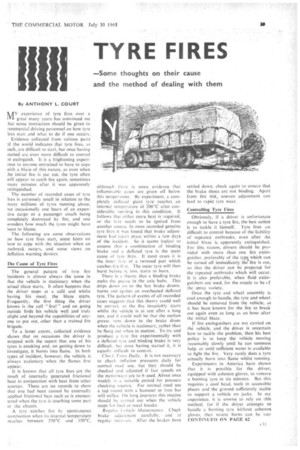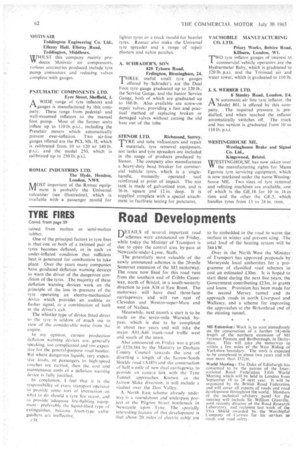11//1 TYRE FIRES —Some thoughts on their cause and the method of dealing with them
Page 61

Page 64

If you've noticed an error in this article please click here to report it so we can fix it.
By ANTHONY L. COURT
MY experience of tyre fires over a great many years has convinced me :hat some instruction should be given to -.'ornmercial driving personnel on how tyre tires start and what to do if one occurs.
Evidence collected from various partg of the world indicates that tyre fires, as ;itch, are difficult to start, but once having nailed are even more difficult to control or extinguish. It is a frightening experi:nee to anyone untrained to have to cope with a blaze of this nature, as even when the initial lire is put out, the tyre often will appear to catch fire again, sometimes many minutes after it was apparently extinguished.
The number of recorded cases of tyre fires is extremely small in relation to the many millions of tyres running about, hut occasionally one hears of an expert-dye cargo or a passenger coach being completely destroyed by fire, and one wonders how much the tyres might have been to blame.
The following are some observations on how tyre fires start, some hints on how to cope with the situation when an outbreak occurs, and some views on deflation, warning devices.
The Cause of Tyre Fires The general pattern of tyre fire incidents is almost always the same in that the vehicle is stationary when the actual blaze starts. It often happens that the driver stops at a café and whilst having his meal, the blaze starts. Frequently, the first thing the driver knows is the call "fire!" and on going outside finds his vehicle well and truly alight and beyond the capabilities of anyone to put out, other than a trained fire brigade.
To a lesser extent, collected evidence shows that on occasions the driver is stopped with the report that one of his tyres is smoking and, on getting down to investigate, it bursts into flame. In both types of incident, however, the vehicle is always stationary when the flames first appear.
It is known that all tyre fires are the result of internally generated frictional heat in conjunction with heat from other sources. There are no records to show that one had been caused by externally applied frictional heat such-as is encountered when the tyre is touching some part of the chassis.
A tyre catches fire by spontaneous combustion when its internal temperature reaches between 250°C and 350°C,
although there is sonic evidence that inflammable gases are given off below this teniperature. By experiment, a completely deflated giant tyre reaches an internal temperature of 200°C after considerable running in this condition. It follows that either more heat is required, or the tyre needs to be ignited from another source. In most recorded genuine tyre fires it was found that brake adjustment had taken place within a few days of the incident. So it seems logical to assume that a combination of binding brake and a deflated tyre is the main. cause of tyre fires. It most cases it is the inner i re of a twinned pair which catches lire lirst. The outer tyre will then burst before it, too, starts to burn.
There is i theory that a binding brake melts the grease in the axle hubs. This drips down on to the hot brake drums. burns and ignites an overheated deflated tyre. The pattern of events of all recorded cases suggests that this theory could well be correct, as the fire invariably starts whilst the vehicle is at rest after a long run, and it could well be that the molten grease runs down to the brake drum when the vehicle is stationary, rather than he flung out when in motion. To try and produce a l■ re fire experimentally with a deflated tre and binding brake is very difficult. but once having started it. it is equally di [lieu It to control. .
Check Tyres Daily. It is not necessary to check inflation pressures daily for normal road use, but they should be checked and adjusted if fast speeds on the molorwas are to b used. About once weekly is a suitable period for pressure checking routine. For normalroad use a .tap round with a hammer or iron bar will suffice. On long journeys this routine should be e,,rricd out when the vehicle stops for fuel or meal breaks.
Regular Vehicle Maintenance. Check brake adjustment ,carefully, and at regular interxals. After the brakes have settled down, check again to ensure that the brake shoes are not binding. Apart from fire risk, uneven adjustment can lead to rapid tyre wear.
Controlling Tyre Fires
Obviously, if a driver is unfortunate enough to have a tyre fire, the best action is to tackle it himself. Tyre fires .re difficult to control because of the liability of repeated outbreaks, even after the initial blaze is apparently extinguished. For this reason, drivers should be provided with more than one fire extinguisher, preferably of the type. which can be turned off immediately the fire is out, so that the driver can be prepared for the repeated outbreaks which will occur. It is also preferable, when fluid extinguishers are used, for the nozzle to be ef the spray variety.
Once the tyre and wheel assembly is cool enough to handle, the tyre and wheel should be removed from the vehicle, as it has been known for the fire to break out again even as long as an hour after the initial blaze.
If fire extinguishers are not carried on the vehicle, and the driver is uncertain how to tackle the problem, then his best policy is to keep the vehicle moving reasonably slowly until he can summon help, or until sufficient water is available to fight the fire, Very rarely does a tyre actually burst into flame whilst running.
Experiments in America have shown that it is possible for the driver, equipped with asbestos gloves, to remove a burning tyre in six minutes. But this requires a cool head, tools in accessible places and the ground sufficiently stable to support a vehicle on jacks. In my experience, it is unwise to rely on this method, for if the driver attempts to handle a burning tyre without asbestos gloves, then severe burns can be susCONTINUED -ON PAGE 62
tamed from molten or semi-molten rubber.
One of the principal factors in tyre fires is that one or both of a twinned pair of tyres becomes deflated, or in such an under-inflated condition that sufficient heat is generated for combustion to take place. Over the years many companies have produced deflation warning devices to warn the driver of the dangerous condition of the tyres. The majority of these deflation warning devices work on the principle of the loss in pressure of the tyre operating an electro-mechanical device which provides an audible or flasher signal. or a combination of both in the driver's cab.
The whistler type of device fitted direct to the tyre is -seldom 'of much use in view of the considerable noise from the engine.
In my opinion, current production deflation warning devices are, generally speaking, too complicated and too expensive for the general-purpose road haulier. But where dangerous liquids, very expertsi1/4,e loads, or passengers in high-speed coaches are carried, then the cost and maintenance costs of a deflation warning device is fully justified.
in conclusion, I feel that it is the responsibility of every transport operator to provide some sort of instruction on what to do should a tyre fire occur, and to provide adequate fire-fighting 'equipment--preferably the liquid-filled type of extinguisher, because foam-type extinguishers are ineffective. c.34












































































































